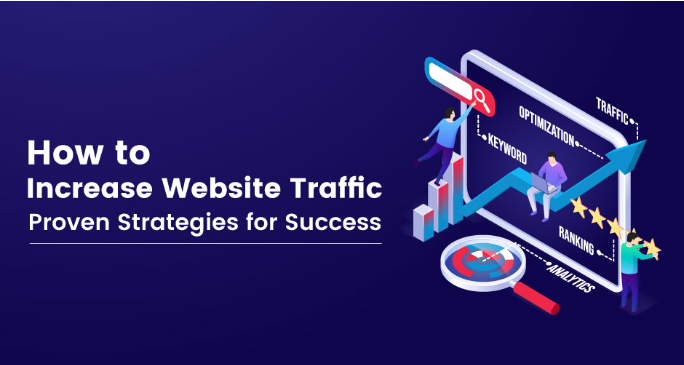Unlock Your Website’s Potential: Effective SEO Strategies for Higher Rankings
We know that the most common type of digital marketing is search engine optimization or SEO. This is vital because it helps improve the level of website exposure, and brings in organic traffic, and in the end positive conversions. Good SEO practices make it easy for the search engines to locate, crawl and index your site pages, resulting to high search rankings on Search Engine Results Pages (SERPs). Here’s an overview of the most critical factors when it comes to website SEO:

1. Keyword Research and Optimization
Finding the correct search phrases comes first in any recession empowering campaign. First, understand the issues and the phrases that people whom you want to reach would type. Tools like Google Keyword Planner, SEMrush or Ahrefs assist in locating keywords with decent search volume but appropriate amount of competition.
These keywords need to be applied to the following topical elements:
Title tags
Meta descriptions
Header tags (H1, H2 and H3)
URL structure
Content body
However, do not engage in keyword stuffing otherwise it may earn you penalties when search engines catch the efforts. Always ensure that the sites containing these phrases have useful information that is based on on such words.
2. On-Page Optimization
On-page SEO as the name goes means the efforts that one makes internally, on individual pages to help in ranking high and get more targeted traffic. Some of the factors related to on-page optimization are:
Title Tags: Each page on the website must have a unique title tag that is keyword rich and resonates with the content of your site.
Meta Descriptions: Include original meta descriptions reflecting relevant, useful content and likely to appeal users back your site.
Header Tags: Use header tags (H1, H2…) to organize content and highlight critical sections.
Alt Text: Write descriptive alt text for images.
URL structure: Make sure your URLs are exact, descriptive and comprise goal key phrases when vital.
Internal Linking: Utilize internal links to force people the pages you want them on, and distribute link equity.
3. Mobile-Friendly Design
Being that mobile search traffic measures up to over half of all web-traffic initiatives, it is crucial for your website design to be friendly when Google leaves its digital breadcrumbs. Mobile-first indexing has been in favor of Google, so the mobile version comes first for being indexed and rank. Make sure your website is responsive so that it adapts to different screen sizes and provides an optimal user experience on all devices.
4. Page Speed Optimization
Page Speed Is A Crucial Factor For SEO Rankings A website that loads slowly translates to a poor user experience as well as higher bounce rates. To work on the page speed, some options are:
Lower the elements on each page to decrease HTTP requests.
Small file size using compression.
Would you crop, resize or compress the images of your website?
Utilize the browser caching for static resources.
Concatenate and Minify CSS, Javascript & HTML Files: Remove unused codes in your site.
Tools like Google PageSpeed Insights or GTmetrix help identify where your site is slower and can be improved.
5. High Quality Content
The most important thing for SEO is content. Search engines like content which is useful enough to be engaging for people using them. Make your content fully-researched, be responsive to the needs of your target audience and keep it up-to-date so that you remain relevant.
The strategy can be kept simple with long-form content.Following the path of creating lengthy topics that are comprehensive also will improve traffic. Additionally, use multimedia elements such as images, videos, and infographics to make your content more engaging.
6. Technical SEO
On the other hand, technical SEO refers to tweaking your site’s backend so search engines can effectively crawl and index it. Some important points to elaborate on Technical SEO are as follows:
XML Sitemap: Submit an xml sitemap to search engines so that they can get new indexed pages.
Robots. txt: Use a robots. Create ROBots.txt file — to allow or disallow pages crawler search engines.
Canonical tags: Avoid duplicate content issues by using canonical tag in the widget to let search engines know which is main version of that page.
Schema markup: Add Schema Markup into your website to make it easy for search engines like Google (Bing) understand what exactly you have in the content.
What we conclude is that you must always ensure and maintain the sound health of your website by using tools such as Google Search Console or Screaming Frog to keep a check on technical SEO, this way none issue will affect the other in leading towards undesirable commitment.
7. Backlink Building
When a high-quality web site provides hyperlinks to your website, search engines take this as an indication that there is something valuable on the linked page and thus placing it nice within the rankings. Instead, focus on creating backlinks worth the quality that will boost your domain authority and rankings. Effective backlink-building strategies include:
Posting as a guest on other sites within your niche.
Asking Influencers and Bloggers to Collaborate
Designing content that is easy to share, such as infographics and articles based on research.
Leveraging broken link-building opportunities when projecting relevant content to serve as a replacement for dead links on other websites.
Stay away from the spammy link building practices type, this will trig penalties and kill your site SEO.
8. User Experience (UX)
UX/User Experience, yes UX is SEO. Search engines want to display the best results possible and as such websites which are user-friendly, well designed or memorable will rank better. To improve UX:
Make sure the site design is intuitive and calls to action are noticeable.
Cut down on pop-ups and invasive ads that may annoy the user.
If this is not the case, make changes to your website or blog so that all people can access it – including those with disabilities.
Create well-organized navigation menus and have easily visible info.
9. Regular SEO Audit
Perform regular SEO audits to identify areas for improvement and ensure your site is aligned with the latest SEO best practices. An SEO audit can help you uncover issues such as broken links, duplicate content, missing meta tags, and crawl errors. Use tools like SEMrush, Ahrefs, or Google Search Console for auditing your site’s performance.
Conclusion
Website SEO optimization is an ongoing process that requires attention to detail and consistent efforts. By focusing on keyword research, on-page optimization, technical SEO, and user experience, you can significantly improve your site’s rankings and drive more organic traffic. Regularly update your SEO strategy to stay ahead of algorithm changes and ensure long-term success.



